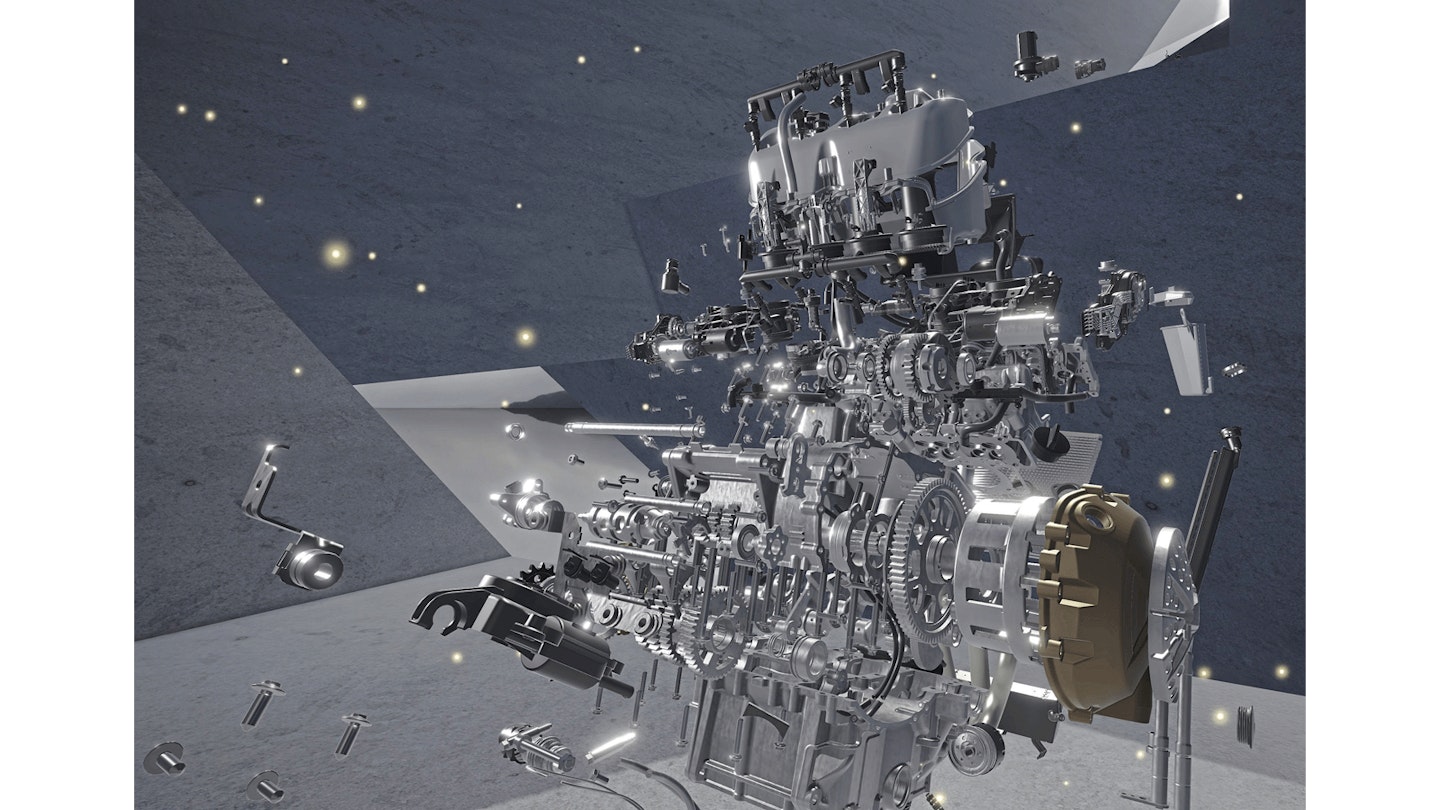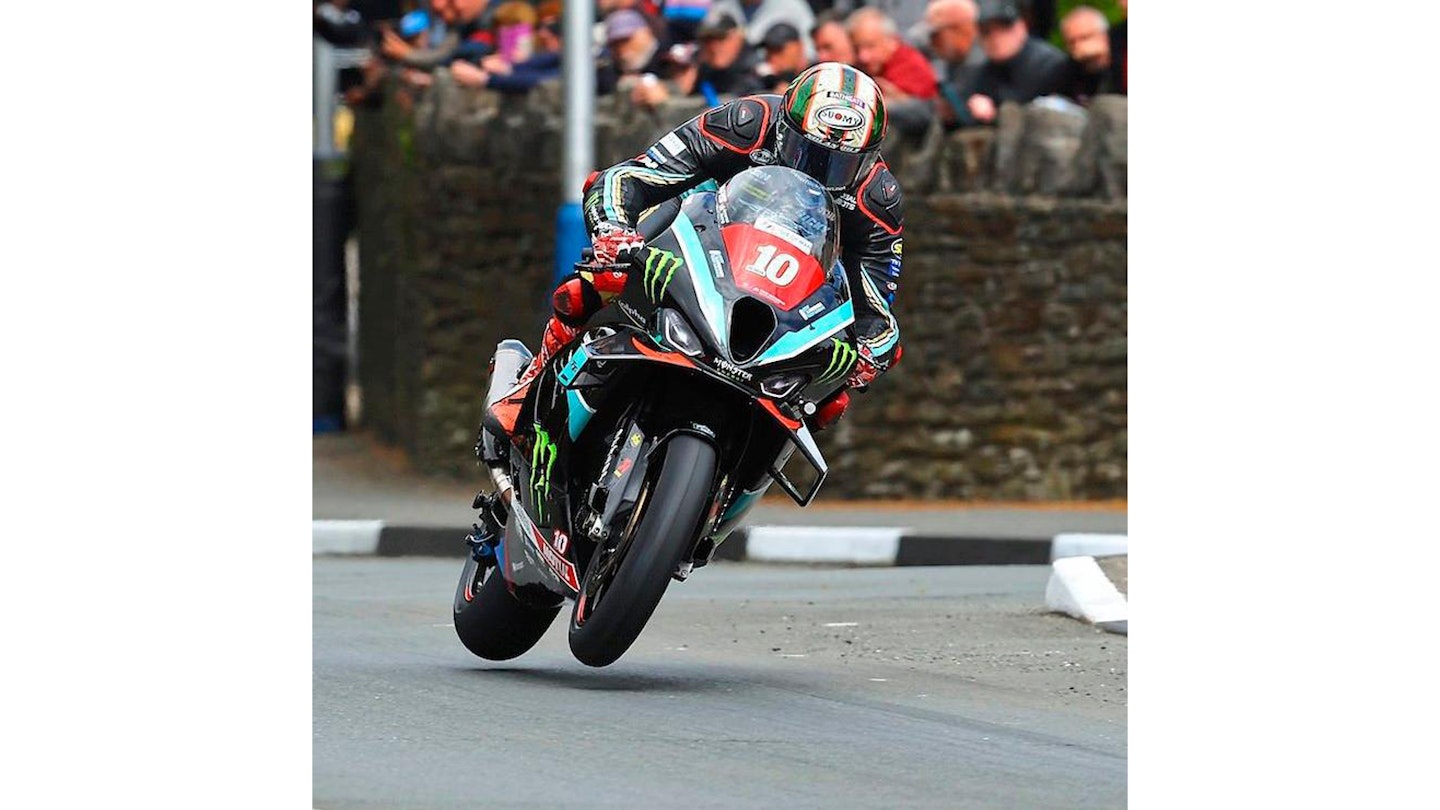Tech
Lapping the Isle of Man isn’t just a huge test of rider – it’s a vast task for their bike. Jamie Turner digs in to see what it does to a BMW M1000RR

It’s amazing that they don’t all do this...

ROUND AND ROUND
Modern engines rev quite a bit. During a typical TT race, the crank of a BMW inline four – it’s in there somewhere – will rotate more than 1,000,000 times. Yes, over a million.
LOTS OF BANGS
Imagine how fast the rear wheel turns, tearing around the TT. And for every rotation there are around 12 combustion events in the engine. It’s a relentless onslaught of explosions and involves enormous forces.

We all know the TT is an ordeal for riders and for their mounts. It’s easy to see that the engines must be under enormous stress throughout practice and the races. The TT has always been an obvious proving ground for manufacturers, after all – the same as all the great races.
A couple of years ago some of Peter Hickman’s BMW M1000RR telemetry was shared with the magazine – it showed the throttle was pinned for 44 per cent of a lap. By digging out some of the spec information for the standard bike and making some (hopefully not too outrageous) assumptions we can put some numbers to things and make some comments. So let’s do that, and hope the results aren’t a damp squib…
Six laps of the 37.73-mile course means the race distance is 226.4 miles or 364.5km; 44 per cent of this is 99.6 miles or as near as damn it 160km. Knowing this, the first thing I’m going to do is calculate how many rotations of the bike’s rear wheel this represents. I’m going to use the road bike information to do this, because the racers have to be close to this and, well, BMW aren’t going to share deep specification secrets with us. The rear tyre is a 200/55 ZR17 which, knowing that this means the sidewall height will be 55 per cent of 200mm and it sits on a 17in rim, means it will have a rolling radius of 32.6cm. In turn this means one complete turn of the wheel will cover a distance of 205cm. Now, we all know tyres squash when you put weight on them, but equally they grow due to centrifugal forces, so I’m going to say that at speed one turn of the wheel will propel the bike this distance.

Peter Hickman and BMW’s M1000RR: quite the combo
Logically then, we can divide 205cm into the distance that represents 44 per cent of the race distance to get the total number of wheel rotations: this turns out to be about 78,300 (a complete race distance is nearly 178,000 rotations). First thing of engineering note: wheel bearings get a real hammering, and I’ll bet most of us hardly ever think of them…
Now, how many engine revolutions is this? Well, this is where I am going to make possibly the biggest assumption/guess – I’m going to use the fifth gear ratio to work this out. The rationale runs something like this: yes, a lot of the lap will be flat in sixth, but not all of it, and there are chunks of low-gear acceleration as well. So, you can’t use sixth, and knowing the circuit is damned fast it doesn’t seem ridiculous to use fifth for a calculation like this. Undoubtedly the telemetry gathered by the team could tell them how many revolutions the engine does, but then that will measure revs in real time and then integrate to get the real number. I can’t do that, not least because I don’t have the data (and my brain isn’t big enough). So, fifth it is.
I managed to find a BMW information fact sheet on t’internet which has most of the information I am going to use here.

Hickman on a gentle trundle on his M1000RR back in 2023
It says that fifth gear is 1.360:1, the primary reduction ratio is 1.652:1, and the chain sprockets are 17/46 for a final drive ratio of 2.706:1. While one may justifiably expect some fiddling with sprocket sizes, I’m going with the homologated numbers. So, multiply those together and you get the fact that, for each turn of the rear wheel, the engine does 6.08 revolutions – this is the fifth gear overall ratio. That means, for each rotation of the wheel, there are just over 12 combustion events (three in each of the four cylinders).
Now, take the number of turns the wheel did over 44 per cent of the race distance and multiply by the fifth gear overall ratio and you get nearly 476,000 engine revolutions. Yes, knocking half a million, with just under 952,000 combustion events. For the whole race distance, it would be comfortably more than a million engine rotations (actually, just over 1,082,000) with north of two million combustions. Clearly, these are Big Numbers.
What else can we calculate? Well, the M1000RR engine has a stroke of 49.7mm, meaning that in one turn of the crankshaft the piston moves a total of 99.4mm. Here I am ignoring the effect of any crankshaft offset in the engine design, but that won’t change things much. Knowing how many revolutions the engine has done means we can work out how far the piston moves under those 44 per cent of the distance conditions – the answer is 29.4 miles (it would be 66.8 miles for the whole race distance if the whole thing was done in fifth). Now, that might not sound like much versus the whole race distance, but the stroke is very short indeed in comparison…
‘Each con rod could lift four to five times the mass of your bike without exceeding design limits’

BMW’s inline four – what madness goes on within
Let’s now look at the loads the engine is under. That 2022 BMW spec sheet gives a maximum power of 156kW at 14,500rpm, which is 209.2bhp in proper money. To generate this the torque has to be 102.7Nm (75.7 lb.ft), representing a drop of 9.1 per cent from the quoted maximum torque of 113Nm/83.3 lb.ft (remember, we’re using data for the 2022 M1000RR). The mean piston speed at maximum power is just over 24m/s – a totally normal number. BMW said they ran it out to 15,000rpm in the race, and for that the mean piston speed is 24.85m/s.
Right, let’s calculate something which, if it doesn’t scare you, should at least make you appreciate the abilities of the engineers who have created the bike you ride – the maximum inertia force on the small end of the connecting rod, which it has to resist as the piston changes direction during overlap and there are no meaningful gas forces on the piston to counteract it. I’ve had to make an assumption on its ‘l/r’ ratio (the rod length divided by the crankshaft throw), but after doing this, at 14,500rpm in the M1000RR, the maximum piston acceleration (the thing that arises from the change in direction) is 73,665m/s2 . This is just over 7500 times the force due to gravity. Newton tells us that force equals mass times acceleration, so to calculate the force involved we now have to assume a piston assembly mass. I am going to say 130g – this may be off, but I am including the mass of the pin, circlips and rings in this. Anyway, multiply that by the acceleration and you get 9576N. Now, divide that by the acceleration due to gravity (or ‘g’), or 9.81m/s2 , and you get the mass that would give that force – it’s 976kg. At 15,000rpm the force trying to pull the pin out of the con rod’s small end eye is comfortably over a ton…
Why do I evoke the engineers who have designed the con rods? Well, assuming the rods in your bike have similar structural capabilities as those in the BMW, each one could lift four to five times the mass of your bike without exceeding its design limits. Of course, the shank of the rod is even stronger – we usually add a third of the mass of the rod to the piston assembly to get the total reciprocating mass. Serious loads are generated there. Whichever way, at maximum power speed this inertia force is being applied many thousands of times a minute, yet the engine holds together. And it’s all going on between your legs…
A force on the piston of more than five tons...

BMW pistons accelerate with 7500 times the force of gravity. Eek
And that’s before we consider the combustion forces. When we consider combustion, the numbers get even bigger.
The forces acting on the small end are, of course, counteracted every other revolution by the gas forces acting on the piston due to combustion. Now, I don’t have a cylinder pressure trace for the BMW, obviously, but highly tuned, naturally aspirated engines will generate a peak cylinder pressure of about 100 bar (one bar is approximately an atmosphere). Given the bore of the engine is 80mm, this produces an instantaneous force on a piston of approximately 50kN – or more than five tons, comfortably bigger than the inertia force, but inwards towards the crank. Subtract the inertia force and that’s about four tons pushing through the rod towards the crankshaft. So the rod itself has to be able to resist massive buckling forces too. (Oh yes, and lest we forget, there is also a five-ton instantaneous force trying to lift the head off the block and fire it through the fuel tank towards your chin. If you ride a Ducati, try not to worry too much where the rear cylinder(s) are pointing…)
Even after nearly 40 years of working with engines, when I calculate numbers like this, I still get a sense of wonder that they work day in, day out, for years on end, and that they can be designed, developed, built and sold for a price that people are happy to pay while making a profit for their manufacturers. The forces and temperatures they sustain are incredible.
Their utility is similarly amazing. While a lap of TT is undoubtedly a stress, Hickman’s bike is not a prototype but a development of a homologated, over the counter product that also passes difficult emissions tests and is a 200+ bhp softy to ride slowly. I would say this, but, really – mechanical engineering, what an amazing thing. And long live the internal combustion engine – very few things are anywhere near as impressive. Especially when you see a TT bike doing massive speeds through urban areas with a complete hero pinning the throttle wide open for nearly half a lap… maybe don’t tell him some of the numbers in this piece, though, eh?
Jamie Turner is Professor of Engines at KAUST. He owns a BMW K1200S and loves two-strokes.
